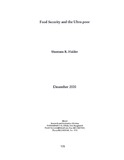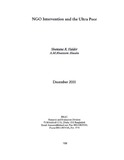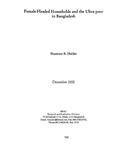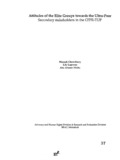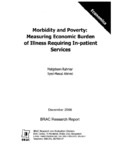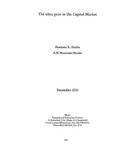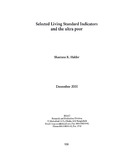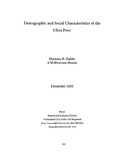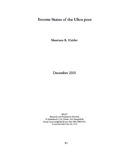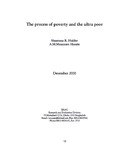Search
Now showing items 1-10 of 10
Food security and the ultra poor
(Research and Evaluation Division, Brac, 2000-12)
This paper aims to derive some policy guidelines by analysing factors affecting food
security of the ultra poor. Here more emphasis is given on the number of rice meals
taken and the sources of rice consumed during the ...
NGO intervention and the ultra poor
(Research and Evaluation Division, Brac, 2000-12)
This report mainly discusses the perceptions of the ultra poor regarding NGO
membership and their future development needs if they join NGOs like BRAC. It also
focuses on reasons for membership discontinuation, issues ...
Female-headed households and the ultra poor in Bangladesh
(Research and Evaluation Division, Brac, 2000-12)
This report focuses on the magnitude of FHHs among the poorest and examines their
socio-economic profile to highlight the distinction between FHHs and the entire
sample. Female-headed households (FHHs) are of two types: ...
Attitudes of the Elite Groups towards the ultra-poor: secondary stakeholders in the CFPR-TUP
(BRAC Research and Evaluation Division (RED), 2003)
"Attitudes of the Elite Groups towards the Ultra-Poor Secondary stakeholders in the
CFPR-TUP" was initiated as a combined effort between Advocacy and RED. Secondary
stakeholders are those that beyond the primary stakeholders ...
Morbidity and poverty measuring economic burden of illness requiring inpatient services
(BRAC Research and Evaluation Division (RED), 2006-12)
Severe illnesses may have important consequences for the poor in terms of the costs of
treatment they have to bear and income erosion effects of those illnesses. The resulting
depletion of wealth may also transmit poverty ...
The ultra poor in the capital market
(Research and Evaluation Division, Brac, 2000-12)
This paper looks into the issue of accessibility of the capital market for the ultra poor
by analyzing the extent of borrowing, their sources and uses of loan. One-fourth had
access to any capital sources, and only about ...
Selected living standard indicators and the ultra poor
(Research and Evaluation Division, Brac, 2000-12)
This report aimed to give a clear picture on the nature of their vulnerability and
potentiality to cope wit by analysis their non-land asset base, ownership of savings and
their level of human poverty. It was estimated ...
Demographic and social characteristics of the ultra poor
(Research and Evaluation Division, Brac, 2000-12)
This report aimed to understand the demographic, social and economic characteristics
of the ultra poor. Analysis of data clearly showed that the ultra poor households were
smaller in size than the rural average. One-third ...
Income status of the ultra poor
(Research and Evaluation Division, Brac, 2000-12)
This paper reports on income status, major sources of income and determinants of
income of the ultra poor Mean per capita income was calculated to be Tk.3,385, per
annum that was even less than the estimated lower poverty ...
The process of poverty and the ultra poor
(Research and Evaluation Division, Brac, 2000-12)
This report focuses on the poverty process - how they become poor, the reasons for
their falling into poverty. Poverty is multi-causal. On average 1.7 causes were identified
by the respondents. Major causes of poverty ...

